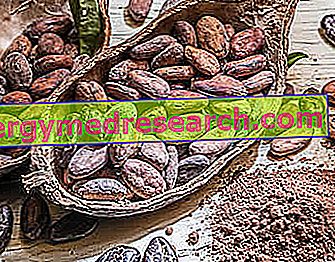Generality
Cocoa beans are the seeds of the Theobroma cacao plant.

Cocoa beans have been known since ancient times; they were in fact already known to pre-Columbian civilizations which - given the numerous properties attributed to them and their characteristic and pleasant taste - gave it the name of "food of the Gods".
The cocoa beans are processed to obtain different products, used in many areas, starting from the culinary one, up to the pharmaceutical sector.

processing
As mentioned, different products are obtained from cocoa beans, which can be used in different sectors.
The processing phases of the cocoa beans include several steps, which can be summarized as follows:
- Preparation of cocoa beans, which are freed from the yellowish pulp that wraps them inside the pods.
- The cocoa beans thus prepared are fermented - generally in special tanks - for a period that can vary from two to ten days. The fermentation of the beans allows the characteristic cocoa smell to be obtained.
- Once fermented, cocoa beans can be sun-dried, or air dried (this procedure, however, is optional).
- Pressing of the cocoa beans, so as to separate most of the fat fraction (containing high quantities of saturated fatty acids) contained in them. This fat part, following refining, will then go to make up the so-called cocoa butter;
- Roasting of cocoa beans which is usually carried out at temperatures between 120 ° C and 140 ° C inside special ovens.
- Grinding of roasted cocoa beans in order to obtain the cocoa powder used in the culinary field.
The cocoa butter obtained by pressing from cocoa beans is a substance rich in saturated fatty acids which, once refined, is used in the culinary, cosmetic and even pharmaceutical fields, as an excipient in medicinal preparations.
Raw and Roasted Cocoa Beans
The toasted cocoa beans have a slightly different chemical composition than that of raw cocoa beans.
Normally, toasted cocoa beans contain:
- Lipid substances (including saturated fatty acids and anandamide);
- Polyphenols, including flavonoids (proanthocyanidins) and catechinic tannins;
- Protein;
- Biogenic amines;
- Isochinolines (such as salsolina);
- Purine alkaloids, in particular, theobromine and caffeine;
- B vitamins and vitamin E;
- Mineral salts, among which we find iron, calcium, zinc, phosphorus, sodium, potassium and magnesium;
- Sugars.
The composition of raw cocoa beans is similar to those of roasted cocoa beans, but not the same. In fact, in raw cocoa beans there should be a greater concentration of thermolabile constituents, since they are not degraded by roasting and by the various stages of processing that instead undergo the toasted cocoa beans. More in detail, it seems that raw cocoa beans guarantee a greater intake of alkaloids, antioxidant substances (such as polyphenols), vitamins and mineral salts, especially magnesium. Not surprisingly, raw cocoa beans are considered rich sources of this mineral and their consumption is recommended in all those cases where a magnesium supplement may be necessary, such as, for example, in sportsmen, or in students to improve the their concentration. Magnesium, in fact, is very important and carries out numerous biological functions in our body at the musculoskeletal, cardiovascular and central nervous system level.
Vice versa, proteins, fats and sugars are present in lower concentration in raw broad beans, being the percentage of water higher than those roasted.
Property
Thanks to their rich and varied composition, numerous properties are attributed to cocoa beans. Among these, we find:
- Antioxidant properties, attributed to cocoa beans, as well as their processing products. These properties, as mentioned, are attributable to the polyphenols contained in them. However, in this case, raw cocoa beans seem to possess more pronounced antioxidant activities, since the polyphenol content is not affected by the processing procedures.
- Anti- inflammatory properties . Studies have shown that the polyphenols contained in cocoa beans not only possess strong antioxidant properties, but also potential anti-inflammatory properties.
- Stimulating properties, attributable to the caffeine and, above all, theobromine content. These molecules, in fact, are endowed with stimulating activities towards the heart muscle and the central nervous system, stimulate concentration and decrease the sensation of fatigue.
- Antidepressant and anti-stress properties . These properties are attributable to biogenic amines, isoquinolines and anandamide present in cocoa beans. All these molecules, in fact, are able to act at the level of the central nervous system, allowing for an improvement in mood and cognitive functions.
Of course, the fact that the substances contained in cocoa beans give them this great range of properties does not mean that they must be consumed excessively.
On the contrary, an excessive consumption of cocoa beans - whether roasted or raw - can lead to the onset of side effects, such as, for example, constipation (due to the content of tannins) and migraine attacks (due to the content of amines biogenic); without taking into account the excessive caloric intake that would derive from an excessive consumption of the aforementioned cocoa beans.
Contraindications
Usually, the consumption of cocoa beans, as well as of the products obtained from their processing, is contraindicated in patients suffering from hiatal hernia; this is because the theobromine contained in cocoa beans and their derivatives can reduce the pressure of the lower esophageal sphincter.



